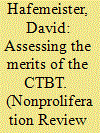|
|
|
Sort Order |
|
|
|
Items / Page
|
|
|
|
|
|
|
| Srl | Item |
| 1 |
ID:
091674


|
|
|
|
|
| Publication |
2009.
|
| Summary/Abstract |
The Treaty on the Non-Proliferation of Nuclear Weapons and the nonproliferation regime have been weakened; perhaps no other issue demonstrates this as dramatically as the status of the Comprehensive Nuclear-Test-Ban Treaty (CTBT), the ratification of which the U.S. Senate rejected in October 1999. Despite the U.S. rejection, the test ban has strong international support-the most recent vote to promote the CTBT in the UN General Assembly passed overwhelmingly, with 175 votes to 1 (the United States) and three abstentions. The Obama administration favors U.S. ratification of the CTBT, but this is no guarantee that Washington will ratify the test ban. Members of Congress must weigh the benefits and risks of signing the treaty; however, these calculations can sometimes be difficult to carry out. This article examines whether a return to nuclear testing would in fact benefit the United States, or if a test ban would be a greater contribution to U.S. national security.
|
|
|
|
|
|
|
|
|
|
|
|
|
|
|
|
| 2 |
ID:
066988


|
|
|
| 3 |
ID:
080446


|
|
|
|
|
| Publication |
2007.
|
| Summary/Abstract |
Progress in monitoring the Comprehensive Nuclear Test Ban Treaty (CTBT) is examined, beginning with the 2002 National Academy of Sciences CTBT study, followed by recent findings on regional seismology, array-monitoring, correlation-detection, seismic modeling, and non-seismic technologies. The NAS-CTBT study concluded that the fully completed International Monitoring System (IMS) will reliably detect and identify underground nuclear explosions with a threshold of 0.1 kt in hard rock, if conducted anywhere in Europe, Asia, North Africa, and North America. In some locations the threshold is 0.01 kt or lower, using arrays or regional seismic stations, but with an increase in background events. As an example, the 0.6-kiloton North Korean test of October 9, 2006 was promptly detected by seismometers in Australia, Europe, North America, and Asia. The P/S ratio between 1-15 Hz clearly showed that the event was an explosion and not an earthquake. The advances in seismic monitoring, described in this article, strengthen the conclusions of the NAS study. Interferometric synthetic aperture radar can, in some cases, identify and locate 1-kt tests at 500 m depth by measuring subsidence to 2-5 mm. InSAR can discriminate between earthquakes and explosions from the subsidence pattern. InSAR will not give a rapid response, but InSAR can locate nuclear tests to within 100 meters, excellent for on-site inspections. Cooperative monitoring can detect yields of 10 kg next to a test site and less than a gram when two meters from experiments without revealing nuclear secrets.
|
|
|
|
|
|
|
|
|
|
|
|
|
|
|
|
|
|
|
|
|